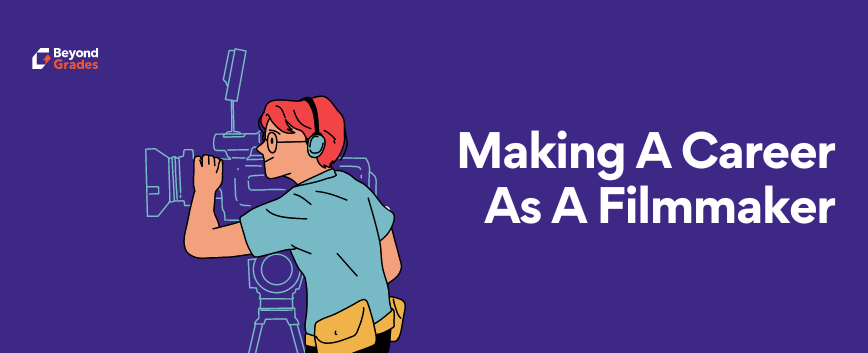[ad_1]
I will guide you towards how you can kickstart your passion for filmmaking with this blog, “the essential guide: filmmaking 101.”
What is filmmaking?
As the name suggests, this is the art of creation through various stages described below.
Films can be documentaries, full-length feature films, short films, etc.
Steps to making your first film!
The production process is one of the most integral parts of creating your dream film. I will take you through these stages of production step by step,
So keep your pen and paper ready and start making notes on what aspects of these stages you need to focus on!
Stage 1- Development (The ideation stage)
This is the inception of your film, the very idea you are choosing to create.
Steps in the development process –
1. Fixing and structuring an idea-
Here you decide what genre and type of content you want to create
Some aspects you need to keep in mind while formulating the “idea.”
- Whether you want to create a fiction or a nonfiction
People usually get confused between fiction and nonfiction, so here are some pointers to help you decide.
Fiction
|
Nonfiction
|
2. Have a rough idea of the logistics and resources you will need
- This would include a rough idea of the budget, equipment, and narrative demand.
If you are beginning to explore this field, having a small budget, r.s 3-4k, and using the equipment you can acquire easily is the best route to establish yourself as an authentic filmmaker.
Stage 2 – Pre-production (The Planning stage)
To give you a detailed structure of pre-production, there are 7 key pointers you should build your idea upon.
1. Plot / Screenplay
- Establish the space, time, and characters
(Example – Introduction: Sarah sits in her bedroom at night thinking about the fight she had with her father) Here space is the bedroom, Sarah is the character, and the time is around might)
2. Storyboarding
- This step is a step-by-step visual narrative you create.
- Storyboarding can do this through drawing or by using software like celtx
3. Scene- Breakdown
Scene-Breakdown is a requirement list you need to make so your shooting process can go smoothly.
This requirement list includes-
- Location (Interiors and Exteriors) (Recce)
- Cast and crew finalization
- Props
- Equipment
- Budget
- Costumes and makeup
- Permission for shooting if required.
4. Mise-En-Scene (Setting up the stage)
- This implies to the domain of art direction you wish to go towards
(Example- You shot is in a 16th century London household, then you will have to create a set that matches the place and have your props, lighting, etc. exactly how 16th century London will look like)
5. Camera
- In this pre-production step, you establish the angles, shots, and movement of cinematography you utilize.
6. Audio
7. Editing
- Here you arrange, organize and sequence your film.
Tip for newbies –
Stages of production are one of the most commonly asked questions when it comes to interviewing rounds. So make sure you are well aware of how the pre-production, production, and post-production process takes place. Interning at production houses can help you establish an idea of how the process of filmmaking works.
| One common mistake for filmmaking beginners is confusing between a story and a plot.
They sound similar, but do not be fooled; they are pretty different. Story: Anyone can tell a story. It is linear with a start, middle and end. Plot: This revolves around how you tell a story. Example: A story where a person suffers from memory loss, takes pictures of people, and gets tattoos to remember things. If this seems familiar, wait a bit. This story has been told in two very different ways by –
Watch the two films, and then you will know how much of a difference the plot can make. That is precisely why when you go to any website to check the summary of a film, the plot is mentioned rather than the story. |
Stage 3 – Production (The Filming stage)
This is the stage of filmmaking that excites most people. It is the actual shooting and recording of a film with the cast, crew, location licenses, equipment, etc.
Pointers before you launch the production process
- Remember there is no turning back from production, so make sure you have all the shots, angles, and techniques you require
- Have a team you can trust and delegate tasks accordingly for the smooth flow of filming.
Stage 4 – Post-Production
Not all departments of filmmaking are present during the production process.
Departments that are present during the production process –
- Cinematography Department
- Art Direction Department
- Directorial department
Steps for post-production
- Arranging the shots
- Sequencing the shots individually
- First-cut of the film for the director and cinematographer
- Fine-Tuning- Here, color correction, color grading, and sound are implemented
- Final Cut of the Film.
Glossary of names while on a shoot
When you go for a shoot, you do not want to be the person who is constantly confused between filmmaking crew positions, so make sure to make yourself familiar with this list of names that will help you do your tasks in the most gracious way.
Understanding above the line vs. below the line
“The line” represents the hierarchical division in the film crew.
All these departments can help you find your most suited job role in the filmmaking industry.
(Here, I have mentioned the average salary of each of these job positions sourced by Glassdoor and ambition box)
Above-the-line crew
These members are responsible for the financial and creative part of the project and are part of all stages of filmmaking.
1. The Director ( ₹40,00,000 per year)
The director is usually found at the top of the filmmaking hierarchy chart as they hold responsibility for the creative flow of the film even though they might not be the ultimate authority.
2. The Producer ( ₹ 2.0 Lakhs to ₹ 15.2 Lakhs per annum )
They are primarily responsible for securing funds and setting the project into motion with their organizational guidelines.
3. The Principal cast (₹35,547 per month)
Key actors and actresses for our film
4. Casting Director ( ₹ 0.3 Lakhs to ₹ 18.2 per annum)
Their job is to find the right performers for the project.
Below the line crew
These are the boots on the ground that play a significant role in the success of any film. Here are the departments of the below-the-line crew and the personnel that represent it –
Below-the-line crew
1. The Assistant Director’s Department
They weave together all the departments and are responsible for scheduling, planning, and communication.
Personnel in the AD department
- The 1st AD ( ₹4.9 Lakhs per year )
- The 2nd AD
- The 2nd 2nd AD
- The set PA ( ₹ 1.1 Lakhs to ₹ 13.5 )
The number of ADs or whether you can even have an AD depends on your filming scale.
For any Independent filmmaker starting their career, this department is not a necessity, but if you are interning at a media house, this department is key to aiding the success of the film
2. The Art Department
The art department helps make your vision into reality as they are responsible for the visual elements of a film.
Personnel in the Art Department
- The production designer (₹ 2.0 Lakhs to ₹ 26.6 Lakhs per year)
- The Art Director ( ₹8,09,407 per year)
- The set dresser (₹24,000 per month)
- The Prop Master ( ₹ 1.2 Lakhs to ₹ 15.8 Lakhs)
- Art PA
3. The camera department
Members of the camera department with the grip and electronic department
Personnel in the camera department
- The director of photography, commonly known as the DOP, has the responsibility to record images per the director’s requirements and vision. (₹26,401 per month)
- 1st and 2nd Assistant Cameraperson (₹ 0.8 Lakhs to ₹ 5.1)
- Digital Imaging Technician (DIT) ( ₹ 3.5 Lakhs)
4. The Electric department
They do the task of creating light by collaborating with the grip department. They execute the plan of lighting as per the vision of the director of photography.
Personnel in the Electric department
- The gaffer (₹5,44,271)
- The best boy electric (BBE)
- Electrical Lighting Technician (ELT)
- The Generator Operator
5. The Grip Department
The task of the grip department is to use the light created by the electric department most creatively by manipulating it through silk, reflectors, and other equipment.
Personnel in the Grip department
- The Key Grip
- The Best Boy Grip
- The Grip
- The dolly grip
6. The Sound Department
As the name suggests, this department is responsible for generating the best on-set sound through various analog and technical innovations.
Personnel in the Sound department
- The Production Sound Mixer ( 4 Lakhs per year )
- The Boom Operator (3.9 Lakhs per year)
- The Sound Assistant/Cable person ( ₹ 3.2 Lakhs to ₹ 4.0 Lakhs per year)
These are some of the major below-the-line departments. Other departments that fall under this category are the VFX Department, the Hair and Makeup Department, The stunts department, and the production department.
| Note –
Remember that the salary of any person under the above-mentioned fields depends upon many factors such as,
|
Key Takeaways
- What is filmmaking?
- Stages of the Production process
- Job Profiles in Filmmaking
| BONUS –
Here are the famous auteurs you can study in order to understand the meaning of “cinematic”
|
Now that you have an idea of how to go about your filmmaking career,
Buckle up your shoes,
And make a run for the first film!
Because experience matters, no matter how low budget your Independent project might be, trust me, if the work is good enough, it can even go to film festivals!
[ad_2]
Source link










